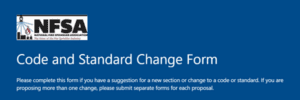Looking Ahead to the 2027 ICC Codes

Looking Ahead…to the 2027 IBC and IFC
By John Swanson

The 2024 editions of the International Building Code (IBC) and International Fire Code (IFC) were finalized in the fall of 2022. While the 2024 code cycle with the International Code Council (ICC) has ended, NFSA’s Codes and Standards Team (CDT) meets monthly, and that team is already looking ahead to 2027 (the next editions of the IBC and IFC) to see what changes should be made.
CDT is composed of NFSA members from around the country that specialize in and are passionate about improving codes and standards. Staff at NFSA rely on the work that CDT does to address changes in the codes and standards in the ICC, NFPA, and similar authorities. The goal is to make sure codes that are adopted and in use around the United States are practical, understandable, and most importantly, emphasize fire sprinklers throughout the built environment.
Here is a summary of some of the code changes that NFSA and CDT are looking at for the 2027 editions of the International Building Code and International Fire Code under the ICC.
- Continue coordinating language throughout the International Codes when referencing “automatic sprinkler systems”. Previously, the International Code Council (ICC) would refer to automatic sprinkler systems using different terminology (“fire sprinklers”, “automatic fire sprinkler system”, “automatic sprinkler system”, etc.).
- Add a requirement in Chapter 39 of the IFC (Processing and Extraction Facilities) that if flammable or combustible liquids are used in the extraction process, the fire area must be protected with an automatic sprinkler system. With more states are legalizing the use of cannabis for recreational and medicinal purposes, it is important these facilities are provided with fire sprinklers when utilizing flammable and combustible liquids.
- IFC Section 903.2.11.4 requires ducts conveying hazardous exhaust (as defined by the International Mechanical Code) to be protected with automatic sprinklers. The exception lists ducts where the largest cross-sectional diameter of the duct is less than 10 inches. NFSA intends to submit a proposal to change this exception to read, “where the largest cross-sectional diameter or width of the duct is less than 10 inches.
- Clarify that NFPA 13D sprinkler systems are permitted in vacation rental and timeshare properties. Renting out of properties by companies such as Airbnb, VRBO, and others has grown steadily over the years. The IBC and IFC classify vacation rental properties as Group R-2. As such, the codes only allow NFPA 13 and 13R sprinkler systems in these properties. Since many of these properties are one- and two-family dwellings, NFPA 13D sprinkler systems should be permitted.
- Clarify that if NFPA 13D is permitted in vacation rental properties, that inspection, testing and maintenance must be done annually. Currently, the IFC does not require annual maintenance for NFPA 13D sprinkler systems.
- Add language in the IBC giving authority to the building official to require an approved firefighting water supply in accordance with the IFC. IFC Section 507 requires an approved firefighting water supply for newly constructed buildings. Currently, there is no criteria giving the building official the authority to require a water supply dedicated to fire protection for new buildings.
- Add new language to Section 912 in the IBC/IFC that establishes a minimum and maximum mounting height for newly installed fire department connections. Currently, the IBC and IFC are silent on how low or high an FDC must be installed in relation to the grade level of the building.
- Add new language to IBC/IFC for fire department connections to be sized in accordance with NFPA 14 when the automatic sprinkler system demand exceeds 1,000 gpm.
The above list represents just some of the code sections, issues, and topics that NFSA may pursue for the next edition of the IBC and IFC. This list will likely change and grow over the next few months.
Do You Have Something in Mind for the ICC? The NFSA is Listening
If you would like to contribute to the work NFSA is doing to improve fire and life safety through the implementation and adoption of model codes, NFSA has setup a link to submit proposals. Use the following link to submit your ideas and comments: Code and Standard Change Form (office.com).
Members and employees of NFSA work very closely in the codes and standards development process, from NFPA to ICC. Our team of experts stay on the cutting edge of fire protection issues. For more information on NFSA’s mission to protect lives and property through the widespread acceptance of the fire sprinkler concept, or to join our association, please visit our membership page.
About the Author…
John Swanson is NFSA’s Codes and Standards Specialist. He came to NFSA in 2021 after a 20-year career with the Minnesota State Fire Marshal Division and serving as a Firefighter with the City of Lakeville, MN for eight years. As a former Deputy State Fire Marshal and Firefighter, he has personally seen the benefits that fire sprinklers make to life safety, firefighter safety and property protection in general. John is passionate about making the built environment safer through the implementation and adoption of model building and fire codes.

